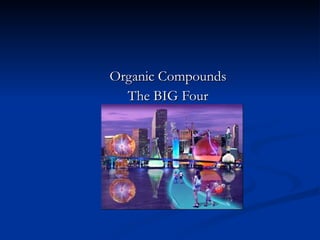
Module 3, lesson 1 organic compounds c 1
- 1. Organic Compounds The BIG Four
- 3. MACRO Micro What do these words mean? So What Is A Macromolecule? A BIG molecule!
- 4. What does “Mono” mean? 1
- 5. Polygons (many sides) Polygamy (many wives) Means... "Poly" Next Word…POLYMER MANY
- 6. Polymers & Monomers Here are some analogies to better understand what polymers and monomers are…. If the train is the whole polymer, what would be the small groups that make up the train? If the necklace is the polymer, what are the monomers that make up the necklace? EXAMPLE of POLYMER MONOMER A TRAIN ? A PEARL NECKLACE ?
- 7. A Polymer Here are some analogies to better understand what polymers and monomers are…. If the train is the whole polymer, what would be the small groups that make up the train? If the necklace is the polymer, what are the monomers that make up the necklace? EXAMPLE of POLYMER MONOMER A TRAIN THE CARS A PEARL NECKLACE EACH PEARL
- 8. The Big Four Now we are ready to begin our study of... There are FOUR important biochemical molecules
- 10. CARBOHYDRATES
- 13. CARBOHYDRATES AT THE ATOM LEVEL Each carbohydrate is made up of… Carbon, Hydrogen, and Oxygen THINK: “CHO”
- 14. CARBOHYDRATES MADE UP OF... Carbohydrates are chains (polymers) made of monomers. The most common monomer of carbohydrates is… Glucose is called a monosaccharide GLUCOSE
- 15. LIPIDS
- 18. LIPIDS AT THE ATOM LEVEL Each lipid is made up of… Carbon, Hydrogen, and Oxygen THINK: “CHO”
- 19. LIPIDS MADE UP OF... Lipids are chains (polymers) made of monomers. The most common monomer of lipids is… Lipids are shaped like the letter “E” TRIGLYCERIDES
- 20. PROTEINS
- 23. PROTEINS AT THE ATOM LEVEL Each protein is made up of… Carbon, Hydrogen, and Oxygen, Nitrogen and sometimes Sulfur THINK: “CHONS”
- 24. PROTEINS MADE UP OF... Proteins are made of long chains (polymers) made of monomers. All proteins are made of the monomer… AMINO ACID
- 25. The shapes of proteins are like a balled up piece of string Amino Acid chain All wound up How the amino acid folds and its resulting shape determine the specific function of the protein
- 27. NUCLEIC ACIDS
- 31. NUCLEIC ACIDS AT THE ATOM LEVEL Each nucleic acid is made up of… Carbon, Hydrogen, and Oxygen, Nitrogen and Phosphorus THINK: “CHONP”
- 32. NUCLEIC ACIDS MADE UP OF... Nucleic Acids are chains (polymers) made of monomers. Nucleic acids are made up of Nucleotides Something we will learn more about when we study DNA
- 33. In interesting point…three out of the 4 types of biochemical macromolecules can be found on food nutrition labels…